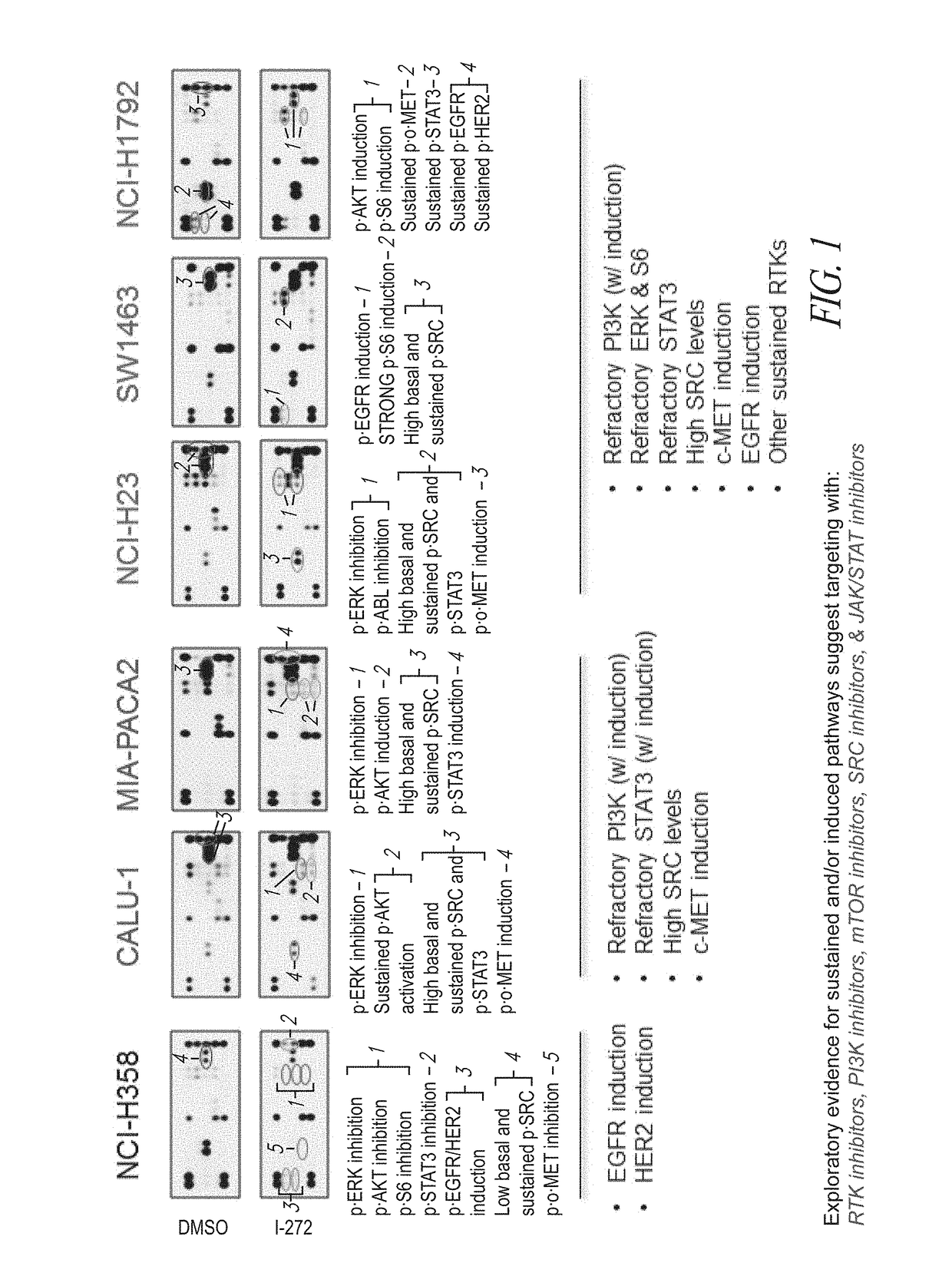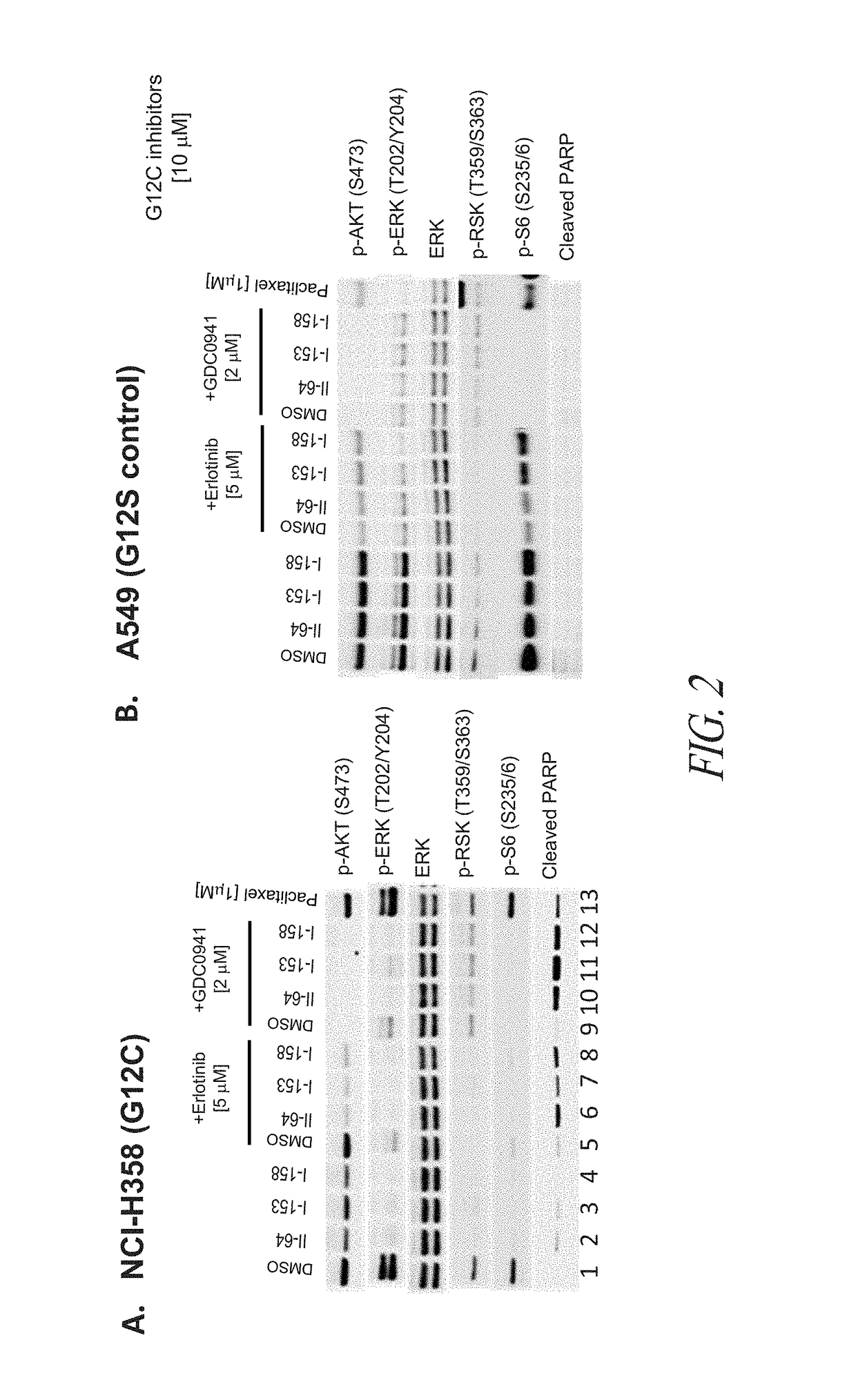Combination therapies for treatment of cancer
a cancer and therapy technology, applied in the field of cancer therapy, can solve the problems of inability to effectively treat cancer, low survival rate, and long time considered impossible to direct target kras
- Summary
- Abstract
- Description
- Claims
- Application Information
AI Technical Summary
Benefits of technology
Problems solved by technology
Method used
Image
Examples
example 1
Strategy for Identifying Signaling Pathways Maintained or Hyper-Activated Following KRAS G12C Inhibition
[0722]Pathways suggesting the need for KRAS G12C targeting compounds in combination with other cancer therapeutics were assessed as follows. Western blots were used to analyze downstream KRAS signaling nodes (AKT, ERK, S6, EGFR / HER2, SRC, MET) and a transcription factor (STAT3). An assessment following treatment of mutant cells (H358, Calu-1, MiaPaca2, NCI-H23, SW1463, H1792) with an exemplary KRAS G12C inhibitor (compound I-272) for 48 hours showed sustained or induced pathways suggesting targeting with RTK, PI3K, mTOR, SRC, and JAK / STAT inhibitors (FIG. 1). Sustained or induced pathways were assessed by comparing untreated cell lines with those treated by compound I-272.
[0723]Specifically, H358 cell lines showed EGFR and HER2 induction, suggesting additional targeting with RTK inhibitors. Calu-1 and MiaPaca2 cell lines showed refractory PI3K and STAT3, both with induction, high ...
example 2
Exemplary KRAS G12C Inhibitor in Combination with One of RTK, PI3K, mTOR, SRC or JAK / STAT Inhibitors
[0724]Cancer therapeutics to target specific pathways induced or sustained by treatment of KRAS G12C cells with an exemplary KRAS G12C inhibitor (compound I-272) were assessed and demonstrated as follows. Therapeutics that are RTK, PI3K, mTOR, SRC or JAK / STAT inhibitors were selected based on data obtained from testing described in EXAMPLE 1. Cancer therapeutics were selected based on their potential to have a synergistic effect on targeted cell lines. Their synergistic effect was assessed and demonstrated as follows. Comprehensive growth inhibition combination tests were performed on mutant cell lines (H358, H1792, Calu-1, SW1463, SW1573, MiaPaca2, NCI-H23) or control cell line (A549) were tested with an exemplary G12C inhibitor (compound I-272, dosing range of 0.063 μM-2.0 μM) alone or with compound I-272 (dosing range of 0.063 μM-2.0 μM) in combination with one of erlotinib (EGFR i...
example 3
Exemplary KRAS G12C Inhibitor Used in Combination with One of an EGFR Inhibitor or PI3K Inhibitor for Synergistic Induction of Apoptosis
[0729]The effectiveness of KRAS G12C targeting compounds in combination with other cancer therapeutics was assessed and demonstrated as follows. Western blots were used to analyze downstream KRAS signaling nodes (AKT, ERK, RSK, S6) and a marker of apoptosis (cleaved PARP). Treatment of H358 cells (KRAS G12C) with exemplary KRAS G12C inhibitors (compounds II-64, I-153 and I-158) alone for 24 hours causes clear and nearly complete inhibition of p-ERK, p-RSK, and p-S6, with partial inhibition of p-AKT (FIG. 2A). However, minimal cleaved PARP is seen, suggesting low levels of apoptosis (FIG. 2A, lanes 2-4 compared to lane 1). Likewise, treatment with erlotinib (EGFR inhibitor, lane 5) or GDC0941 (class I PI3K inhibitor, FIG. 2A, lane 9) alone does not induce robust apoptosis based on cleaved PARP levels (FIG. 2A, lanes 5 and 9 compared to lane 1). Combi...
PUM
| Property | Measurement | Unit |
|---|---|---|
| structure | aaaaa | aaaaa |
| structures | aaaaa | aaaaa |
Abstract
Description
Claims
Application Information
 Login to View More
Login to View More - R&D
- Intellectual Property
- Life Sciences
- Materials
- Tech Scout
- Unparalleled Data Quality
- Higher Quality Content
- 60% Fewer Hallucinations
Browse by: Latest US Patents, China's latest patents, Technical Efficacy Thesaurus, Application Domain, Technology Topic, Popular Technical Reports.
© 2025 PatSnap. All rights reserved.Legal|Privacy policy|Modern Slavery Act Transparency Statement|Sitemap|About US| Contact US: help@patsnap.com



